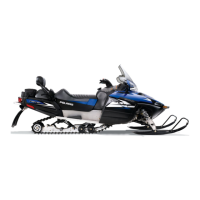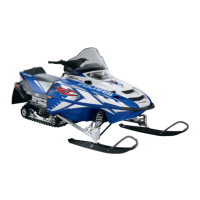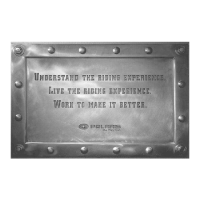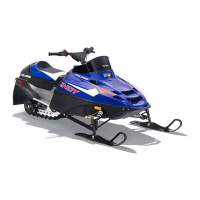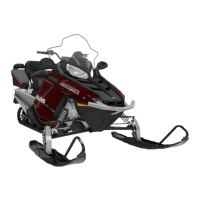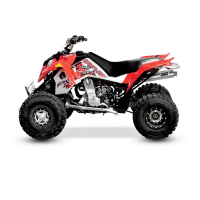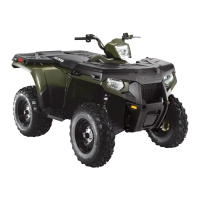4.7
Fuel Systems
4
The main system is designed to deliver fuel between low speed
and high speed operation. This system is made up of the jet
needle, needle jet, and main jet. The main system begins to take
effect as soon as there is enough air flow into the carburetor
venturi to draw fuel up through the main jet and needle jet
assembly. This system works in conjunction with the needle jet
system.
During low speed driving, there is very little clearance between
the jet needle and the needle jet; therefore, very little fuel from
the main jet can pass between the jet needle and the needle jet.
As the throttle valve opening is increased, the tapered jet needle
is raised farther out of the needle jet, allowing greater fuel flow.
Under full throttle opening, the cross sectioned area of clearance
between the jet needle and the needle jet becomes greater than
the cross sectioned area of the main jet. Thus the main jet is now
controlling the amount of fuel flow.
Pilot Jet
From idling to low speeds, the fuel supply is metered by the pilot
jet. There are several air bleed openings in the sides of the pilot
jet which reduce the fuel to mist. The number stamped on the jet
is an indication of the amount of fuel in cc's which passes
through the jet during a one minute interval under a given set of
conditions.
Fuel Screw
The fuel screw controls the fuel mixture from idle to low speeds.
The tapered tip of the fuel screw projects into the passage
leading to the by pass out let. By turning the screw in or out, the
cross sectional area of the air passage is varied, in turn varying
the fuel screw varies the amount of air/fuel.
Main Jet
When the throttle
opening becomes
greater and the area
between the needle jet
and jet needle increases,
fuel flow is metered by
the main jet. The number
on the jet indicates the amount of fuel which will pass through
it in one minute under controlled conditions. Larger numbers
give a greater flow, resulting in a richer mixture. Main jets are
screwed directly into the needle jet base.
Jetting Guidelines
Changes in altitude and temperature affect air density, which is
essentially the amount of oxygen available for combustion. In
low elevations and cold temperatures, the air has more oxygen.
In higher elevations and higher temperatures, the air is less
dense.
Verify the production setting for your specific model. All
carburetors must be re-calibrated if operated outside the
production temperature and/or altitude range. The main jet
installed in production is not correct for all altitudes and/or
temperatures. Refer to the jetting cart in the Specifications
Chapter of this manual for correct jetting for altitude/
temperature ranges.
NOTE: It is the owner's responsibility to ensure that
the correct jets are installed in the machine for a
geographical area. Be very careful when jetting
down in warm weather. As the weather turns colder
it will be necessary to re-jet upward to prevent
engine damage. When selecting the proper main jet
always use the lowest elevation and temperature
that is likely to be encountered.
CAUTION
A Main Jet that is too small will cause a lean operation
condition and may cause serious engine damage. Jet
the carburetors carefully for elevation and temperature
according to the jetting charts in the, Specifications
Chapter of this manual or the models Owner’s Manual
Supplements.
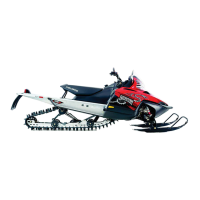
